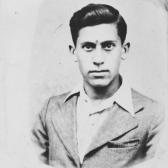
-
Learn More about Haim
Haim was the youngest of 5 children. His family lived in a small Jewish community in the village of Bivolari in Romania. Life was pleasant in this small, but bustling village inhabited primarily by 200 or so Jewish families.
On August 23, 1939, Germany and the Soviet Union signed a nonaggression pact and divided up eastern Europe. The Soviets occupied Bessarabia, one kilometer from Bivolari. The Romanian authorities, suspicious of Jewish loyalties because of the close proximity of the Soviets, ordered all Jews to leave Bivolari and to move further west. Haim and his family moved to the town of Iasi, approximately 50 kilometers to the southwest.
Iasi was a very Jewish city but was also home to the virulently antisemitic Iron Guard organization. While his father and older brothers started a business in yard goods, Haim tried to continue his schooling. In 1941, the Germans in alliance with Romanian troops invaded the Soviet Union. On June 26th, Iasi was subjected to a bombing by the Soviet Air Force. Because the Romanian authorities blamed the Jews for the bombing, a brutal city-wide pogrom was initiated on the 28th and 29th of June. Up to 13,000 Jews were murdered. Haim and his family managed to escape death by hiding throughout the city. Soon after, Haim was recruited by the Romanian authorities to perform forced labor by way of bookkeeping in a military hospital.
In March 1944, Soviet troops reached the Romanian border. Haim and his family went to Bucharest to escape the street fighting. They arrived in Bucharest in June of 1944 and remained there until the arrival of the Soviet troops. In 1945, Haim resumed his schooling and prepared to make his way to Palestine. En route to Palestine in the summer of 1947, the ship on which Haim, along with thousands of other Jews, were traveling was captured by the British. All of the passengers were taken to Cyprus. Finally on December 23, 1948, Haim, now a member of the Hagana, managed to escape the British displaced persons camp on Cyprus and succeeded in reaching Israel.
He remained in Israel until 1952, when he went to live with his brother in Detroit and began his studies in microbiology at Wayne State University. Haim was a volunteer at the United States Holocaust Memorial Museum.



